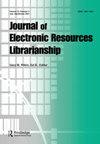讲述技术服务故事:传递价值
Q3 Social Sciences
Journal of Electronic Resources Librarianship
Pub Date : 2022-06-24
DOI:10.1080/1941126X.2022.2064141
引用次数: 0
摘要
例如,第三章(“资金管理”)、第四章(“订购”)和第七章(“持续资源”)将是学习馆藏管理术语的优秀入门读物。其他章节对联络员在认证审查、藏品筛选和图书馆联盟中的潜在作用进行了通俗易懂的解释。总之,这本薄薄的书全面概述了联络员在图书馆藏品生命周期中的作用。第二章(“收藏发展”)和第五章(“藏品发展委员会”)揭示了新图书馆员可能会花大量时间在收藏发展的两个领域。正如作者所指出的,联络责任的现实比简单地选择书籍要复杂得多。尽管如此,这两章为读者提供了当前收藏开发实践的简洁概述,以及进行工作的通用模型。每一章都包括案例研究的例子、模板和经验教训,让读者相信作者是根据经验写作的。第六章(“建立关系”)和第九章(“收集评估和除草”)介绍了联络责任的两个方面,根据当地的制度文化,这两个方面可能令人担忧。Armstrong和Dinkle提供了与校园系教员建立关系的合理建议,显然是借鉴了多年的经验。他们也很现实,接受那些对任何形式的图书馆外联活动都没有反应的部门和教职员工。作者阐明了合理的剔除参数,概述了大多数图书馆可以承担的假设剔除项目。Armstrong和Dinkle为图书馆提供了一个理想的模式,让联络馆员参与馆藏管理。然而,他们对当地的做法很现实。本书中最有价值的工具是每一章的“当地实践问卷”。这些问卷不仅是新联络人的有用框架,还可以帮助收集经理组织培训材料或预测常见问题。《图书馆联络员收藏管理培训指南》是一本易于使用和实用的手册,适用于任何承担新的联络员和收藏开发职责的图书馆员。本文章由计算机程序翻译,如有差异,请以英文原文为准。
Telling the Technical Services Story: Communicating Value
example, chapters three “(Fund Management”), four (“Ordering”), and seven (“Continuing Resources”) would be excellent primers for a new library professional learning the jargon of collection management. Other chapters offer accessible explanations of a liaison’s potential role in accreditation reviews, collection weeding, and library consortia. In all, this slim volume is a comprehensive overview of a liaison’s role in the life cycle of library collections. Chapters two (“Collection Development”) and five (“Collection Development Committee”) demystify two areas of collection development that new librarians may imagine they will spend a lot of time on. As the authors point out, the reality of liaison responsibilities is much more complex than simply choosing books. Nonetheless, these two chapters offer the reader a succinct overview of current collection development practices, as well as a common model for doing the work. Each chapter includes case study examples, templates, and lessons learned, giving the reader reassurance that the authors write from experience. Chapters six (“Building Relationships”) and nine (“Collection Assessment and Weeding”) introduce two aspects of liaison responsibilities that can be fraught, depending on local institutional culture. Armstrong and Dinkle provide sound advice about building relationships with faculty in campus departments, clearly drawing on years of experience. They are also realistic and accepting of departments and faculty that are unresponsive to library outreach of any kind. The authors articulate reasonable parameters for weeding, outlining hypothetical weeding projects that most libraries could undertake. Armstrong and Dinkle offer libraries an ideal model for engaging liaison librarians in management of the collection. However, they are realistic about local practices. Among the most valuable tools in this book is each chapter’s “Local Practices Questionnaire.” These questionnaires are not only a useful framework for new liaisons, they may also help collection managers organize training materials or anticipate common questions. The Library Liaison’s Training Guide to Collection Management is an accessible and practical manual for any librarian who is taking on new liaison and collection development responsibilities.
求助全文
通过发布文献求助,成功后即可免费获取论文全文。
去求助
来源期刊

Journal of Electronic Resources Librarianship
Social Sciences-Library and Information Sciences
CiteScore
1.50
自引率
0.00%
发文量
46
期刊介绍:
A journal for information professionals who work with managing electronic resources in libraries The Journal of Electronic Resources Librarianship (renamed from The Acquisitions Librarian to reflect the journal"s broader focus) provides a much-needed scholarly forum for librarians and other information professionals. This peer-reviewed quarterly journal addresses evolving work-related processes and procedure, current research, and the latest news on topics related to electronic resources and the digital environment"s impact on collecting, acquiring, and making accessible library materials. The journal provides opinion pieces, the latest news, book reviews, conference presentations, and e-resources related updates.
 求助内容:
求助内容: 应助结果提醒方式:
应助结果提醒方式:


